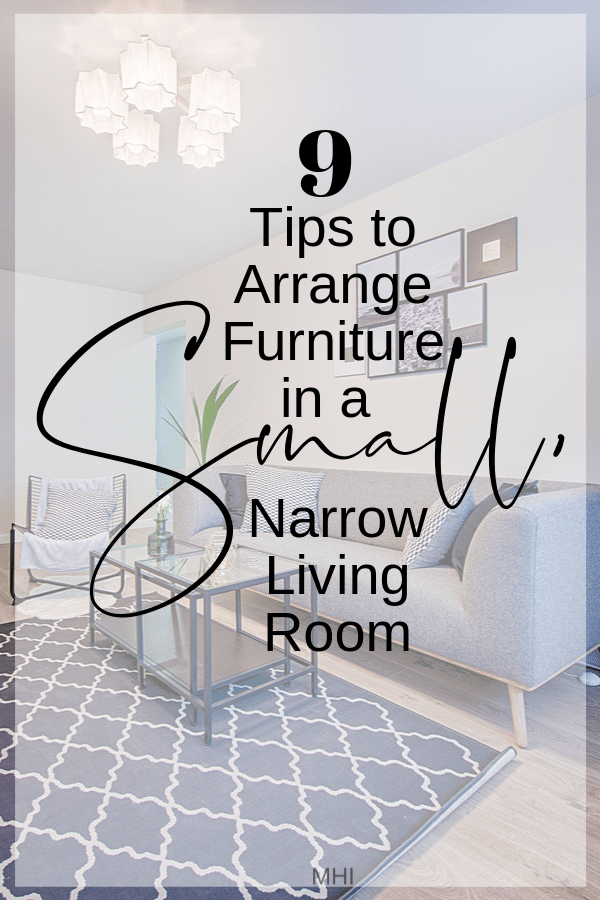Ahh, the dreaded long narrow living room… You love everything about your house but this space, am I right? Where is the TV going to go? Will everyone be able to see it? How can this space even work? It’s so weird! I hear these questions all the time. Narrow spaces can pose a challenge but, keeping a few key things in mind will help you figure out the best layout for your tricky space. Let’s nip this problem child space in the bud so you can get back to loving your whole house! It’s time to learn How to Arrange your furniture in a small, narrow living room.
Measure Your Space.
There’s no sense in trying to bring all your stuff into this space if it isn’t going to fit. If you already have furniture in there and it doesn’t work, that’s fine, that’s why you’re here and you’ll learn how to make it work. This step saves your back.
You don’t want to move everything around and 8 different ways to Sunday if you don’t know how much space you have. After moving sofas, tables and shelves around and getting frustrated, I guarantee you will give up before you arrive at the perfect layout. If you need help, let’s cross this task right off the list.
Essentially, you need to know the length and width of the space along with measurements of each wall segment all around the room. 1. This lets you know what kind of usable space you have so you know what will fit and where. 2. You will have a cross reference to verify the actual size of the room by checking the overall measurements against the sum of your wall segments. Don’t forget to measure doorways, windows and ceiling height. Click the link below for exactly how to do this right.
Use a Rug to Define the Space
Once you determine how large the space is, you have a very solid idea what size rug to get. In my opinion, an 8’ x 10’ or 11’ rug will work in just about any size room. If you’re not sure, this size is a safe bet. Going smaller will only make the space feel narrow and confined.
Rugs are the anchor for the room. They help to define space: a seating arrangement, entry way, dining area, etc. Even if you have wall to wall carpet, I typically overlay a rug to help bring in definition to the space.
Rugs will also help you create the color palate for the space. If you have a rug with pattern and color, you can pull the colors for the upholstery, accents, art and wall color from it. This is a fantastic way to build a color theme for the space.
Sofa Goes on the Longest Wall
Placing the sofa on the longest wall, without obstructions, is the general rule of thumb. Obstructions are things like doorways, tall windows, built-in bookcases, the fireplace. This is because the sofa is probably one of the largest footprints in the room and it needs the most amount of space.
The average sofa is 90” long by 38” deep. Yours may be smaller or slightly larger. When you place an object with these dimensions on a smaller wall it will look cramped and jammed in. If you’re looking for a comfortable layout, this is really the way to go.
Place Something Perpendicular to the Length of the Room
I like to place something long on one end of the room, perpendicular to the length. This provides balance and symmetry. I usually don’t go the entire length of the shorter side but, I will center the piece on the wall and use about 75% of the space.
I like the idea of long console tables or shallow cabinets for this space because they are functional, many times having drawers or shelves for display and organization, and they provide depth. They act as a buffer against the shorter wall so you’re not pushing seating back into corners.
Use your Vertical Space
Take advantage of tall ceilings in a long narrow space. If you’re lucky enough to have 10’ ceilings, highlight them with decorative moldings or trim. This will bring your eye up and will diminish the size and shape of the room. If your ceilings are the typical 7.5’, you can still capitalize on the illusion of height by hanging your curtain rods high. This fools your eye into believing there is an abundance of space between the top of the window and the ceiling. I attach my hardware as far up to the ceiling as I can: right below the molding or a couple of inches below the ceiling line.
Another way to use the vertical space is to bring in a tall etagere or open shelving. This is a great way to highlight the height of the space. When you know how high the ceilings are, you can purchase the tallest piece that will fit without being crammed right up to the ceiling.
Always leave room, about 12” to 18” between the top shelf and the ceiling because it provides openness. You can merchandise the top of the shelf but don’t cram a bunch of stuff that on top that hugs the ceiling. Keep it simple and place a tall item on one side and layer objects in front of it.
Resist the temptation to fill the top shelf or any of the shelves for that matter, with a lot of stuff. When you can see the wall peeking through your display, it provides depth and makes the space feel larger. So, edit books, décor and pictures so they don’t overwhelm the space.
Consider Your Walkway
Back to the furniture placement. When you’ve arrived at how much seating you need, it’s time to consider the walkway or paths though the space. Don’t place furniture in doorways or clearly defined walkways. Trust me, you’ll hate having to sidestep the arm of the sofa to move into an adjacent room.
Think about how much space you need to move around accent furniture as well. I like to use the largest cocktail table in front of my sofa as possible. This is not a must but, I like a piece that has visual weight that balances the visual weight of the sofa. So, the way I usually go is a rectangular cocktail table in a narrow room.
Round usually doesn’t work because I want something that is about 60% to 75% the size of the sofa. If you like rounded edges, an oval shape can work well. The thing to keep in mind, with a long piece like this, is the depth. You don’t have to have something that is as wide as a dining table with short legs. You can certainly have a long, thin, coffee table that affords you more space to move around it.
If long and skinny isn’t you taste, go for something larger. Keep in mind, you need at least 18” between the front of the sofa and the coffee table and a minimum of 24” to move comfortably around walkways.
Remove unnecessary clutter
This is a definite in smaller spaces. Clutter is the enemy. A lot of stuff closes off visual lines and makes small spaces feel smaller. Take the time to edit your stuff and spread it around the room. I like to use the rule of 3 and 5. Take 3 items of varied heights and group them together. Layer the items by height, stack smaller items on a book or decorative box. Don’t line them up, you want to vary the height and the lines and create a little vignette. This works just as well for 5 objects too. Odd numbers work best. When you start getting into groups of 9 objects, it can look cluttered.
Think about creating little visual stories with your décor: If you went on a trip display a picture with a few keep sakes that remind you of the trip. Maybe you have a piece of pottery and a basket that you brought back. Display them together with a framed picture of you on the trip.
Curating your stuff is a much better way to show it than stacking stuff together with no rhyme or reason.
Create a Focal Point
The television usually goes opposite the largest upholstered piece in the room. For this example, that’s the sofa. As a rule, I avoid placing the TV in front of windows. I just don’t like that look.
If possible, I prefer the TV to be mounted on the wall next to the window above a long media cabinet.
Having the TV on a swing arm that can articulate out to watch and be flush with the wall when off, gives options for functionality.
If you don’t have a TV, I will capitalize on a beautiful view or the fireplace as the focal point.
Divide Your space
I like to break up a long narrow room with a divider screen or etagere because they give the illusion there is more space behind them or depth to the room. Room dividers help bring definition to the space. Suddenly a long room gets a bit of “mystery” and a narrative, what’s behind the screen? Even if it’s right in front of the wall, it adds a little romance by giving a space a bit of height and dimension.
If you want to add a little drama, think about using a screen that have a decorative carving on it or an opaque cover that can still pick up light and shadow.
Incorporate Round Accent Pieces
You don’t want to have a slew of long rectangular or square pieces in a long narrow room. The room itself is a rectangle and that shape doesn’t need to be reinforced more.
Placing furniture with round shapes and curved angles will break up the harsh straight lines. Place round accent tables near secondary seating. I also like to use demilune tables in a rectangular space because they are a different shape and they add functionality without adding more angles to the mix.
Think about using upholstered furniture with rounded arms. This will soften the space more. Having squared off arms on the sofas and chairs would reinforce the sharp lines and “boxy” feel of the room.
Conclusion:
In order to really get the furniture arrangement of your long, narrow living down, you need to:
• Know the size of your room.
• Use an area rug to define your space.
• Place the sofa on the largest wall.
• Place something perpendicular to the length of the room.
• Use your vertical space.
• Consider your walkways.
• Remove unnecessary clutter
• Create a focal point
• Divide your space
• Incorporate round accent pieces
Thank you so much for stopping by to read today. I appreciate your time and attention so much! I’d love to hear about how you were able to get your tricky small space arranged. Tell me all about your trial and errors in the comments below. Small spaces can be a challenge but, when you get them right, they’re usually the rooms you want to spend the most time in. If you need help with other small space layouts or have a decorating challenge that you need some help with, feel free to leave a comment below or get in contact with me here. I’d love to connect with you and help you out!
Here’s a Few Things to Read Next:
WHY DARK PAINT COLOR CAN MAKE YOUR SMALL ROOM FEEL BIGGER
9 GENIUS HACKS TO MAXIMIZE YOUR SPACE IN A SMALL BEDROOM
DON’T MAKE THIS EXPENSIVE COMMON MISTAKE IN YOUR SMALL SPACE.
Until next week, stay amazing and keep your dreams big for your small space!
“Michael Helwig was top-notch, very professional and responsive to my needs. He allowed me time to explore ideas and try out a variety of combinations until we found the perfect fit. Michael provided detailed information and offered beautiful ideas to make my dream living room become a reality. The furniture he sourced has totally transformed my living room space. Everyone that has seen my new living room has one word, WOW! A special thank you to Michael for a wonderful experience.”
“Michael was very knowledgeable and guided us, with great patience and good humor, through the process of designing our dining room and helping us find the perfect sleeper sofa. He offered really helpful advice when we asked questions - which was often - but at no time did we ever feel pushed. He helped me when I felt like I couldn’t make one more decision. When my new furniture finally arrived I realized everything down to the pillows was perfect. I couldn’t be happier!”
Michael is Principal designer and blogger at Michael Helwig Interiors in beautiful Buffalo, New York. Since 2011, he’s a space planning expert, offering online interior e-design services for folks living in small homes, or for those with awkward and tricky layouts. He’s a frequent expert contributor to many National media publications and news outlets on topics related to decorating, interior design, diy projects, and more. Michael happily shares his experience to help folks avoid expensive mistakes and decorating disappointments. You can follow him on Pinterest, Instagram and Facebook @interiorsmh.








